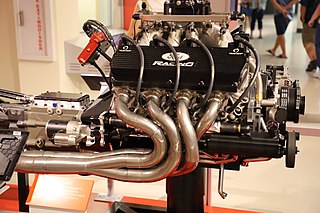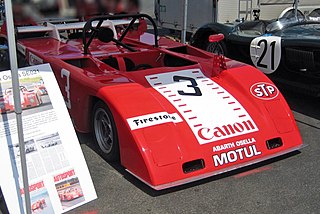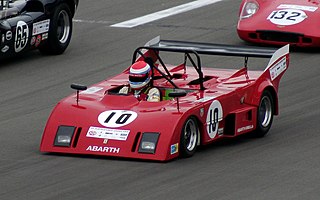
Abarth & C. S.p.A. is an Italian racing- and road-car maker and performance division founded by Italo-Austrian Carlo Abarth in 1949. Abarth & C. S.p.A. is owned by Stellantis through its Italian subsidiary. Its logo is a shield with a stylized scorpion on a yellow and red background.

Dino was a marque best known for mid-engined, rear-drive sports cars produced by Ferrari from 1957 to 1976. The marque came into existence in late 1956 with a front-engined Formula Two racer powered by a brand new Dino V6 engine. The name Dino was used for some models with engines smaller than 12 cylinders, it was an attempt by the company to offer a relatively low-cost sports car. The Ferrari name remained reserved for its premium V12 and flat-12 models until 1976, when "Dino" was retired in favour of full Ferrari branding.

ASA was an Italian automobile manufacturer active from 1961 to 1969, who is known for manufacturing the ASA 1000 GT. This car was developed by Ferrari engineers in the late 1950s as a less expensive, compact alternative to existing Ferrari GT cars. ASA used inline-four and straight-six engines derived from the "250" 3-litre V12 designed by Gioacchino Colombo. The chassis was developed by Giotto Bizzarrini and was derived from the tubular frame chassis of the 250 GTO.

The Ford small-block is a series of 90° overhead valve small-block V8 automobile engines manufactured by the Ford Motor Company from July 1961 to December 2000.
The Ferrari P was a series of Italian sports prototype racing cars produced by Ferrari during the 1960s and early 1970s.

The Nissan A series of internal combustion gasoline engines have been used in Datsun, Nissan and Premier brand vehicles. Displacements of this four-stroke engine family ranged from 1.0-liter to 1.5-liter and have been produced from 1967 till 2009. It is a small-displacement four-cylinder straight engine. It uses a lightweight cast iron block and an aluminum cylinder head, with overhead valves actuated by pushrods.

The Lancia Rally was a mid-engine sports car and rally car built by Lancia in the early 1980s to compete in the FIA Group B World Rally Championship. Driven by Markku Alén, Attilio Bettega, and Walter Röhrl, the car won Lancia the manufacturers' world championship in the 1983 season. It was the last rear-wheel drive car to win the WRC.

The Chrysler Hemi engine, known by the trademark Hemi or HEMI, refers to a series of high-performance American overhead valve V8 engines built by Chrysler with hemispherical combustion chambers. Three generations have been produced: the FirePower series from 1951 to 1958; a famed 426 cu in (7.0 L) race and street engine from 1964-1971; and family of advanced Hemis (displacing between 5.7 L 6.4 L from 2003 to the present.

The Fiat 2300 is a six-cylinder executive car which was produced by Italian automotive manufacturer Fiat between 1961 and 1968. The 2300 was made as saloon, estate car and coupé. The 2300 saloon is noteworthy as in 1966 it became the first Fiat model to be available with an automatic transmission.

The Maserati 250S, and its derivative and version, the 250 Sport, are sports racing cars, designed, developed and built by Italian car manufacturer Maserati, between 1954 and 1957. Only two models were produced.

The Ferrari SP was a series of Italian sports prototype racing cars produced by Ferrari during the early 1960s. All featured a rear mid-engine layout, a first for a Ferrari sports car. Major racing accolades include the 1962 European Hill Climb Championship, two overall Targa Florio victories, in 1961 and 1962, and "1962 Coupe des Sports" title.

NASCAR, the highest governing body and top level division for stock car racing in the United States, has used a range of different types of engine configurations and displacements since its inaugural season in 1949. The engines are currently used in the Cup Series, Xfinity Series, Camping World Truck Series, and the Whelen Modified Tour.

The Fiat Abarth 1000SP is a Group 4 and Group 6 sports racing car built by Abarth in 1966 and 1970.

Abarth Simca GT refers to a number of sports cars produced by Italian manufacturer Abarth between 1962 and 1965.

The Abarth-Osella 2000 Sport SE-021 is a mid-engined, Group 5, prototype race car, built by Osella to compete in the World Sportscar Championship sports car racing series in 1972, and for some races in 1973. The chassis itself was developed and developed by Osella, while the car itself was powered by a 2.0 L (120 cu in) Abarth four-cylinder engine, generating a healthy 265 hp (198 kW). Since the light and nimble chassis only weighed 530 kg (1,170 lb), this gave it an incredible power-to-weight ratio. It was entered 39 times in races, and had 10 podiums. It scored 8 wins in its career.

The Abarth-Osella PA1 is a 2-liter Group 5 prototype racing car built by Osella in collaboration with Abarth, to compete in the World Sportscar Championship sports car racing series in 1973, but was used in active competition through 1982.

The Chevron B16 was a Group 4 sports prototype race car, designed, developed, and built in 1969 by the British racing car manufacturer Chevron Cars as a two-seater racing sports car for the makes world championship. Brian Redman won the very first outing, the 500 km (310 mi) race at the Nürburgring on September 7, 1969, at a time of 3:13:01.6 hours. The last victory with a Chevron B16 was achieved by Clemens Schickentanz on July 11, 1971, in the sports car race at the Norisring.

The Ferrari 125 C is an open-wheel single-seater racing car, designed, developed, and produced by Ferrari in 1947 as a single example. It competed primarily in Formula Libre contests and events.
The Fiat Abarth OTR 1000, alternatively known as Fiat Abarth 1000 OTR, is a sport subcompact model automobile produced by the Italian automobile manufacturer Abarth. With its special "Radiale" engine, it was built between 1964 and 1969 in various versions in very small numbers based on the Fiat 850.

The Borgward 1500 RS was a racing sports car in the class with up to 1.5 liters displacement, which the Carl F.W. Borgward G. mb H. Automobil- und Motoren-Werke presented at the International Motor Show in Frankfurt am Main in 1951. Until 1958, nine cars of this model were built and continuously developed. The Borgward RS was a successful car, but despite good engine performance, it was often inferior to the Porsche 550, which had better driving characteristics.



















